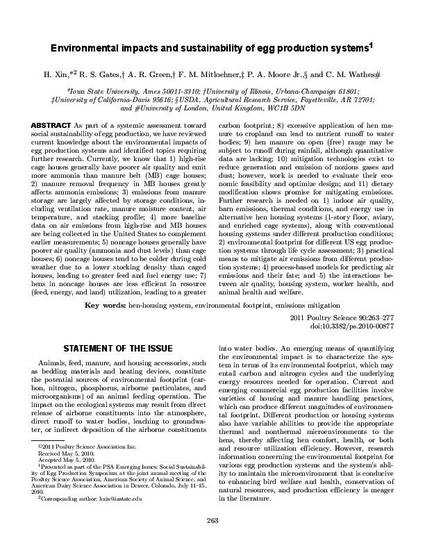
As part of a systemic assessment toward social sustainability of egg production, we have reviewed current knowledge about the environmental impacts of egg production systems and identified topics requiring further research. Currently, we know that 1) high-rise cage houses generally have poorer air quality and emit more ammonia than manure belt (MB) cage houses; 2) manure removal frequency in MB houses greatly affects ammonia emissions; 3) emissions from manure storage are largely affected by storage conditions, including ventilation rate, manure moisture content, air temperature, and stacking profile; 4) more baseline data on air emissions from high-rise and MB houses are being collected in the United States to complement earlier measurements; 5) noncage houses generally have poorer air quality (ammonia and dust levels) than cage houses; 6) noncage houses tend to be colder during cold weather due to a lower stocking density than caged houses, leading to greater feed and fuel energy use; 7) hens in noncage houses are less efficient in resource (feed, energy, and land) utilization, leading to a greater carbon footprint; 8) excessive application of hen manure to cropland can lead to nutrient runoff to water bodies; 9) hen manure on open (free) range may be subject to runoff during rainfall, although quantitative data are lacking; 10) mitigation technologies exist to reduce generation and emission of noxious gases and dust; however, work is needed to evaluate their economic feasibility and optimize design; and 11) dietary modification shows promise for mitigating emissions. Further research is needed on 1) indoor air quality, barn emissions, thermal conditions, and energy use in alternative hen housing systems (1-story floor, aviary, and enriched cage systems), along with conventional housing systems under different production conditions; 2) environmental footprint for different US egg production systems through life cycle assessment; 3) practical means to mitigate air emissions from different production systems; 4) process-based models for predicting air emissions and their fate; and 5) the interactions between air quality, housing system, worker health, and animal health and welfare.
Available at: http://works.bepress.com/richard-gates/46/

This article is from Poultry Science 90, no. 1 (2011): 263–277, doi:10.3382/ps.2010-00877.